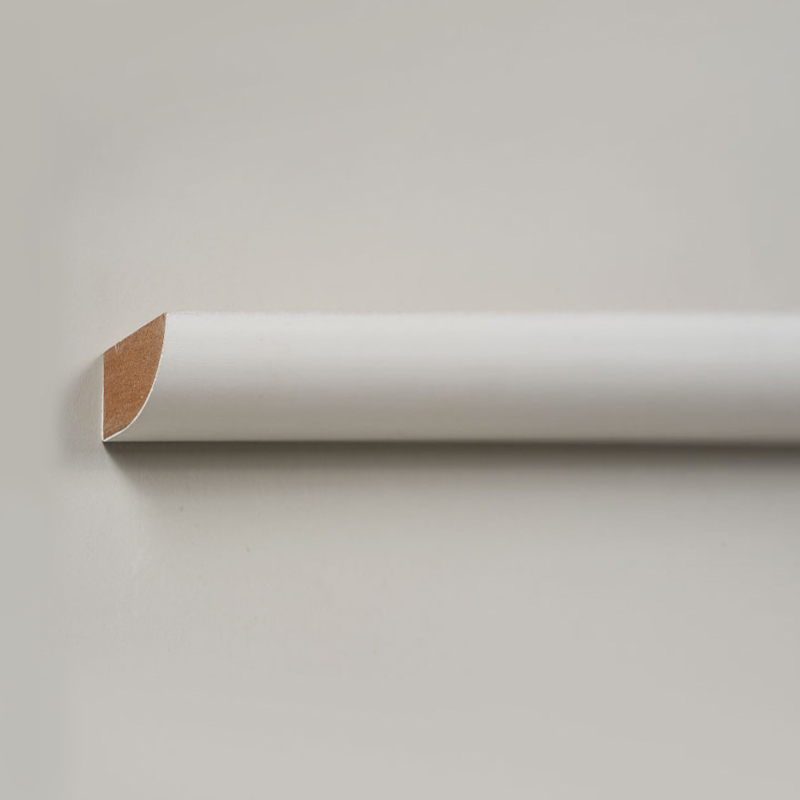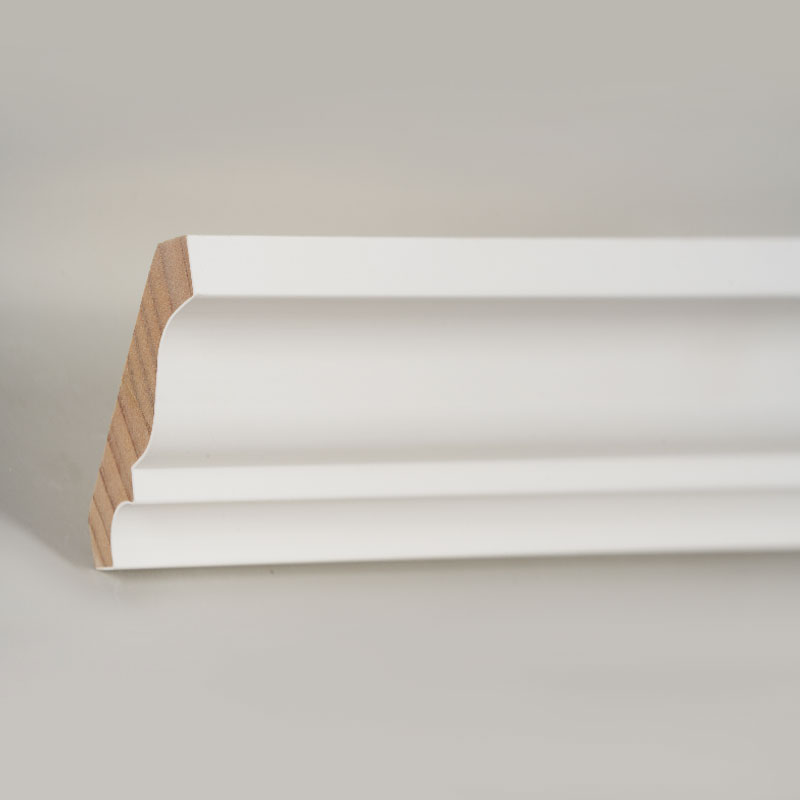Primed Pine Quarter Round: The Perfect Paint-Ready Solution
When it comes to achieving a flawless painted finish in trim work, primed pine quarter round moulding stands out as the superior choice for both professional contractors and DIY enthusiasts. The priming process is not merely a coating; it is a critical manufacturing step that seals the wood's porous surface, creating an ideal substrate for top-coat paints. This pre-treatment prevents the pine from absorbing excessive amounts of paint, ensuring uniform color and sheen while significantly reducing material costs and application time. For projects demanding a sleek, modern aesthetic with perfectly consistent white or colored trim, starting with a primed product is non-negotiable.
The quality of the primer and its application directly impacts the final result. A high-quality primer will offer excellent adhesion and block potential tannin bleed from the wood, which can stain through the topcoat if not properly sealed.
Technical Specifications of Primer Treatment
The priming process involves several technical parameters that ensure optimal performance. The primer must penetrate the wood surface sufficiently to lock down the fibers while building a smooth, continuous film on the surface.
- Coating Thickness: A dry film thickness of 2-4 mils (0.05-0.10 mm) is typically ideal, providing adequate sealing without obscuring the wood's detail.
- Adhesion Strength: Using cross-cut tape tests, a properly applied primer should achieve a rating of 4B or 5B, meaning less than 5% of the coating is removed, indicating exceptional adhesion.
- Solids Content: High-solids primers are preferred as they provide better filling and sealing properties, leading to a smoother surface and requiring less topcoat.
Surface Preparation Before Installation
Even though the moulding arrives pre-primed, some site preparation is recommended for a truly professional outcome. This involves a quick light sanding with fine-grit sandpaper (e.g., 220-grit) to remove any minor imperfections or dust nibs that may have occurred during shipping or handling. After sanding, wiping the surface with a tack cloth ensures it is free of dust before the final painting.
Stain Grade Pine Quarter Round: Enhancing Natural Wood Beauty
For those seeking to highlight the warm, authentic character of wood, stain grade pine quarter round offers an unparalleled opportunity. Unlike paint-grade materials, stain-grade pine is carefully selected for its clear, consistent grain pattern with minimal knots or defects. The open grain structure of pine accepts stain beautifully, allowing for a wide range of color options, from light natural tones to deep, rich hues. This makes it the perfect complement to hardwood floors, staircases, and other stained woodwork, creating a cohesive and elegant interior design.
The key to a successful stained finish lies in understanding the wood's properties and preparing it correctly. Pine can sometimes absorb stain unevenly, leading to a blotchy appearance, but this can be easily mitigated with the right techniques.
Essential Staining Techniques
To achieve a professional, hand-crafted look, following a meticulous staining process is crucial. Rushing this stage can undermine the natural beauty of the wood.
- Wood Pre-Treatment: Always use a pre-stain wood conditioner. This product partially seals the wood, ensuring the stain penetrates more evenly and preventing blotchiness, which is common in softwoods like pine.
- Stain Selection Guide: Choose between oil-based and water-based stains. Oil-based stains penetrate deeper and are often easier for beginners to apply evenly, while water-based stains dry faster and have lower VOC levels.
- Application Method: Apply the stain with a clean cloth or a high-quality brush, working along the grain. Wipe off excess stain after a few minutes to control the color intensity. For a darker shade, apply a second coat after the first has fully dried.
Grain Presentation and Finish Comparison
The final step is protecting the stained wood and enhancing its depth. Applying a clear topcoat, such as polyurethane, is essential. A satin or matte sheen is popular for trim as it reduces glare and hides minor imperfections, while a gloss sheen offers maximum durability and is easier to clean, making it suitable for high-traffic areas.
The Perfect Partner for Hardwood Floors: A Professional Installation Guide
Using pine shoe moulding for hardwood floors is a standard industry practice that serves both a functional and aesthetic purpose. Hardwood floors naturally expand and contract with changes in humidity and temperature. A perimeter expansion gap is crucial to accommodate this movement and prevent the floor from buckling. Pine shoe moulding is the ideal solution to elegantly conceal this gap while protecting the baseboard and wall from damage caused by mopping, vacuuming, and foot traffic. Its flexibility allows it to follow the contours of a slightly uneven floor, creating a clean, continuous line.
Proper installation is key to ensuring the moulding performs its function without hindering the floor's natural movement.
Managing Floor Expansion Gaps
The expansion gap is a non-negotiable aspect of professional hardwood floor installation. The size of the gap can vary based on the floor material and the installation environment.
- Standard Gap Width: A gap of 10-15 mm (3/8 to 5/8 inch) is typically recommended around the entire perimeter of the room, including fixed objects like columns.
- Material-Specific Considerations: Engineered hardwood may require a smaller gap than solid hardwood due to its greater dimensional stability. Always refer to the flooring manufacturer's guidelines.
Finishing and Transition Details
The final detail work separates a good installation from a great one. Use a color-matched wood putty to fill the nail holes. For a seamless look, choose a putty that matches the stained or painted finish of the moulding. Caulking the top seam where the moulding meets the baseboard is also recommended for a fully finished appearance that blocks dust and insects.
Customization Services: Meeting Unique Project Demands
The need for custom sizes pine quarter round arises in many scenarios, from historic home renovations where standard profiles don't match the original trim to modern designs requiring specific proportions. Standard quarter round is typically available in set sizes like 3/4" or 1/2" radii, but these may not be suitable for every application. The ability to customize allows for design flexibility and problem-solving, ensuring that the trim work is perfectly scaled to the room and complements other architectural elements.
At Huzhou Huicheng Home Technology Co., Ltd., our capability as a manufacturer allows us to cater to these specific needs directly, providing clients with tailored solutions that off-the-shelf products cannot offer.
Precision Custom Manufacturing Capabilities
Our custom manufacturing process is designed for accuracy and flexibility, ensuring we can deliver exactly what your project requires.
- Dimensional Accuracy Control: We utilize advanced milling equipment to produce custom profiles with tolerances within ±0.5 mm, ensuring a perfect fit and consistent appearance throughout the installation.
- Minimum Order Quantity (MOQ): While we accommodate large commercial orders, we also understand the needs of smaller projects. Our flexible MOQ policy makes custom millwork accessible for a wider range of clients.
- Profile Matching: We can replicate existing profiles for restoration projects or work from technical drawings to create entirely new designs for contemporary interiors.
Material Comparison Analysis: Making an Informed Decision
The debate of pine vs mdf quarter round comparison is common among homeowners and contractors. Both materials have distinct advantages and ideal use cases. Pine, as a natural solid wood, offers the benefit of being stainable, repairable, and having a traditional warmth. MDF (Medium Density Fiberboard), an engineered wood product, boasts superior stability and a perfectly smooth surface for painting. The best choice depends on the project's specific requirements regarding moisture, budget, finish, and installation environment.
Understanding the core performance differences is essential for selecting the right product that will perform well and look great for years to come.
Performance Parameter Comparison
The following table provides a clear, side-by-side comparison of the key characteristics of Pine and MDF quarter round moulding.
| Parameter | Pine Quarter Round | MDF Quarter Round |
| Durability & Hardness | Moderate (Janka ~380-420 lbf). Can dent but is also repairable. | Surface is hard and resistant to denting, but edges can be fragile and are difficult to repair if damaged. |
| Moisture Resistance | Can swell and warp with prolonged moisture exposure. Requires a protective finish. | Poor. Will swell and disintegrate if exposed to standing water. MR-MDF is a better option for damp areas. |
| Finish Flexibility | Excellent for both staining and painting. | Ideal for painting only. Cannot be stained to look like real wood. |
| Cost | Generally moderate, varies with grade. | Typically the most cost-effective option. |
| Environmental Factor | Renewable resource, biodegradable. | Made from recycled fibers, but uses synthetic resins. |
Recommended Application Scenarios
Based on the comparison, we can derive clear application guidance. Choose Pine Quarter Round for: staining to match other woodwork, historic renovations, and in areas where repairability is valued. Choose MDF Quarter Round for: projects where a perfectly smooth painted finish is the priority, in budget-conscious applications, and in low-moisture interior environments.
FAQ
What is the difference between quarter round and shoe moulding?
While the terms are often used interchangeably, there is a subtle technical difference. A quarter round has a perfectly uniform profile that is exactly one-quarter of a circle, meaning its height and width are equal. Shoe moulding, on the other hand, often has a slightly different, more elongated profile where the height and width are not equal. In practical terms, both are used for the same purpose—to cover the expansion gap between the floor and the baseboard—and the choice often comes down to aesthetic preference and which profile better fits the specific installation.
Can I use pine quarter round in a bathroom?
It is possible, but with significant caution. Pine is a natural wood and is susceptible to swelling and warping if exposed to consistent moisture and humidity. If you wish to use pine quarter round moulding in a bathroom, it is absolutely critical to seal it completely with a high-quality, waterproof finish. This means multiple coats of a moisture-resistant primer and paint on all sides, including the back. For a more worry-free solution in bathrooms, kitchens, or basements, we recommend a PVC or moisture-resistant MDF (MR-MDF) quarter round, which are inherently designed to withstand damp conditions.
How do I fix a gap between my quarter round and the floor?
A small gap appearing after installation is not uncommon and can be caused by seasonal settling or minor floor movement. For a painted pine quarter round, the most effective and professional solution is to apply a flexible, paintable caulk along the gap. Ensure the caulk is labeled for use with wood and flooring. For a stained quarter round where caulk would be visible, the best fix is to carefully remove the moulding, re-cut the pieces to fit more snugly, and reinstall them. This ensures the natural wood look remains uninterrupted.
Is primed pine better than raw pine for painting?
Yes, for almost all applications, primed pine quarter round is superior to raw pine for painting. The factory-applied primer provides a sealed, uniform surface that prevents the wood's tannins from bleeding through the paint (which causes yellow or brown stains). It also ensures even paint absorption, resulting in a smoother finish with fewer coats and a more consistent color. Using raw pine requires you to perform the priming step yourself, which adds time, cost, and the risk of an imperfect seal if not done correctly.
What type of nail gun is best for installing pine quarter round?
A fine finish nailer, typically using 18-gauge or 16-gauge brad nails, is the ideal tool for installing pine shoe moulding. An 18-gauge nailer leaves very small holes that are easy to fill, making it perfect for the delicate nature of quarter round. A 16-gauge nailer offers slightly more holding power for a more secure installation. The nail length should be long enough to penetrate through the moulding and into the baseboard and wall stud, but not so long as to puncture pipes or wires in the wall—a 1.5-inch nail is commonly used. Always angle the nails to increase holding power.

 English
English Español
Español


